The renaturation of the Niers & near-natural spaces between Aspermühle and Kessel.
As already described in the blog article "The Aspermühle - In the change of time", the Niers was straightened in 1932 with the intention to make it usable as a waterway.
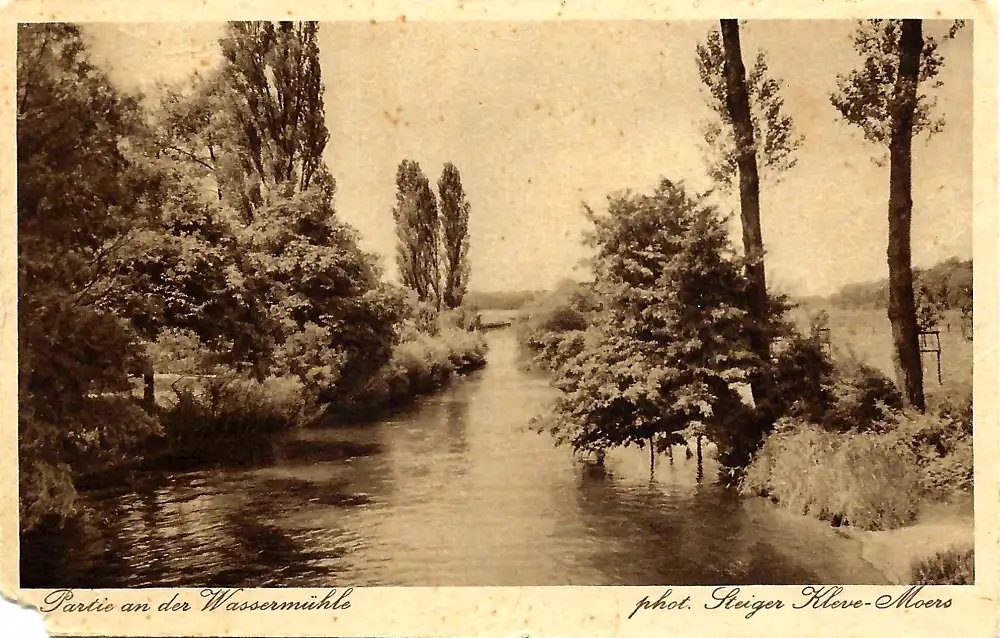
Niers before straightening
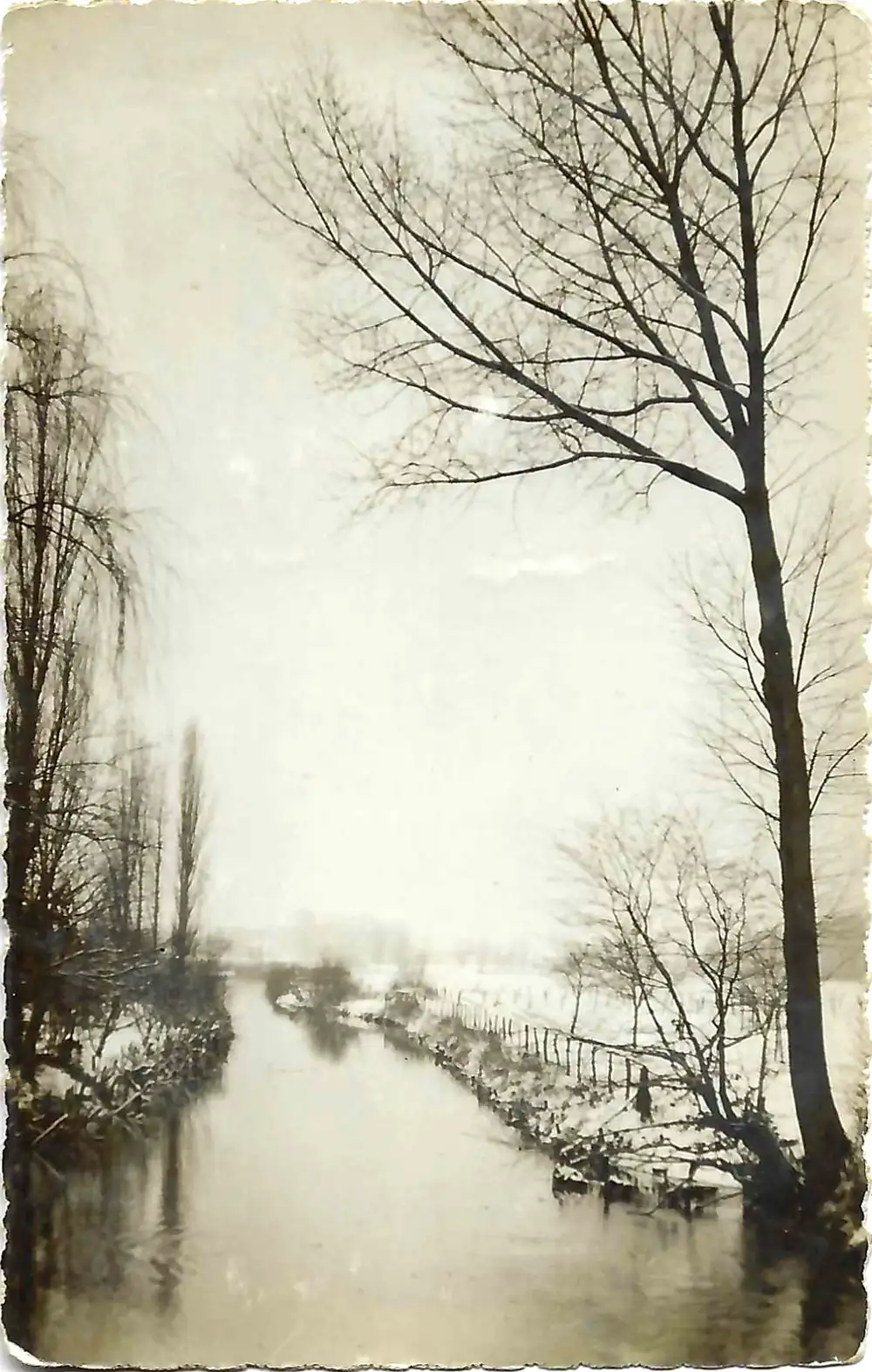
From today's point of view, this is of course no longer desirable in terms of landscape and species protection, especially since the Niers has never been used as a waterway and this is no longer an option today.
Thus, the Niers was renaturalized between 2018 and 2019 on a section of 1.1km before and after Kessel. The aim of the renaturation is to create habitat, protect species, restore the natural balance and an intact ecosystem, and improve water quality and flood protection.
How exactly this was implemented is explained in the following section.
Measures of renaturation on the Niers:
Renaturalization involved restoring the river's naturally twisted course, including deepening and widening it and introducing side arms.
In this way, the course of the river was extended by 700m and the newly created side arms add an additional 800m to the course.
In addition, the banks were lowered, which of course automatically resulted in the formation of islands, peninsulas, floodplains and wet meadows.
Furthermore, various dead wood areas were created.
These measures can be seen from an aerial perspective in the following video.
The renaturation has the following advantages:
More habitat for (water)birds, insects, amphibians and plants:
Widening/deepening and meandering of the river course:
By widening, deepening and meandering(twisting) the course of the river, introducing new side arms and lowering the riparian zone, the existing water volume is distributed over a significantly larger area, reducing the flow velocity and water level of the Niers.
Especially the inner sides of the meanders (river meanders), where the flow velocity of the water is additionally slowed down, are particularly popular with frogs, fish and dragonflies for egg laying, because here the eggs are not carried away by the current and the water temperature is higher in this area due to the low water level.
After hatching, the dragonfly larvae, tadpoles and young fish feel particularly comfortable here.
https://www.bund-naturschutz.de/tiere-in-bayern/libellen/lebensweise
The slow-flowing water and the newly created wet areas of the Niers are also advantageous for insects, as they can quench their thirst better here.
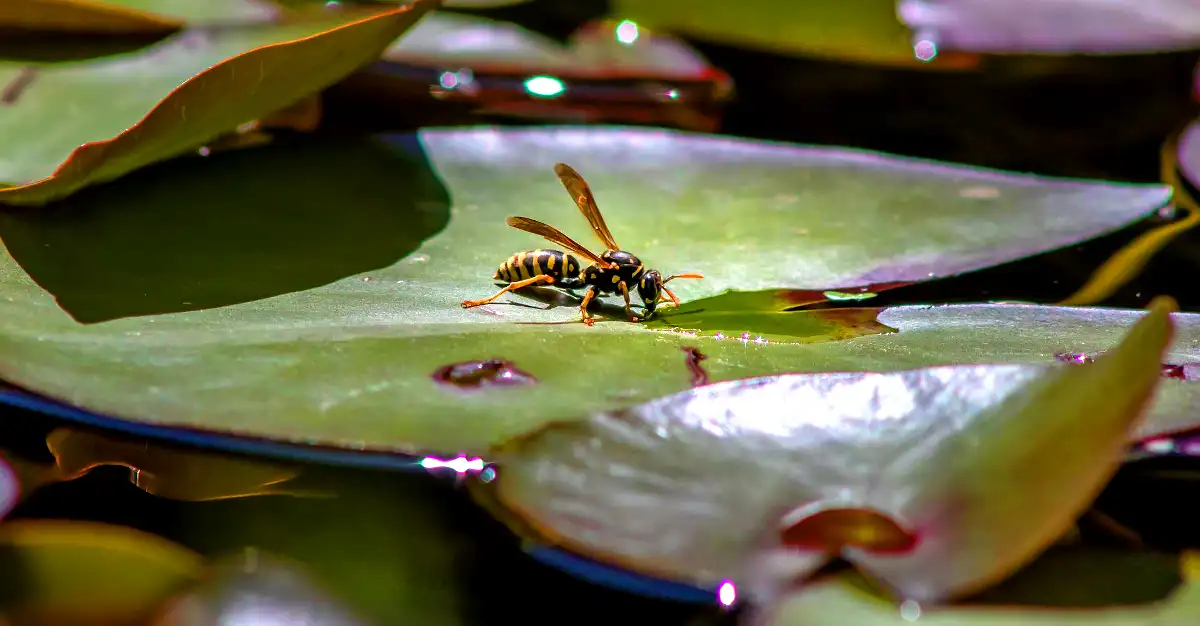
Breeding areas, shelter and habitat for birds:
For swans and other water birds, such as the coot, the gray heron, rails and cormorants, the Niers becomes more attractive, because they prefer standing or slow-flowing waters.
The reed zone (see photo), which was also created by the renaturation, is an optimal breeding area for water birds.
The reed zone is the biotope area that is located directly on the shore or in the shallow water zone and is overgrown with cattails, reeds, water swaths and similar plants.
This area has both a fortifying effect for the bank and at the same time purifies the water as the plants absorb pollutants and break them down over time.
It also provides protection for waterfowl from raptors and other nest predators.
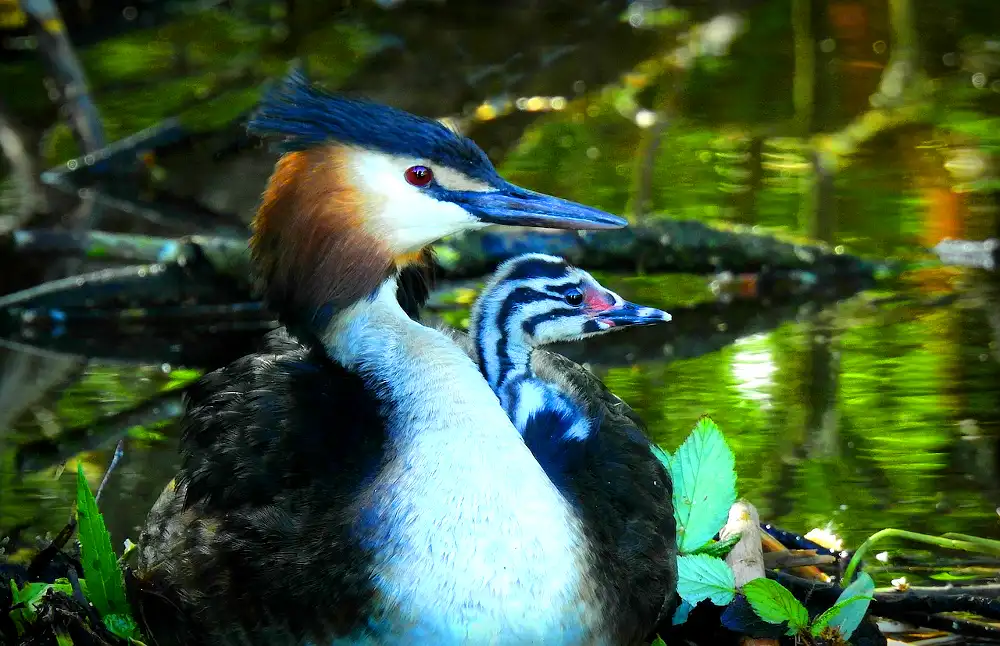
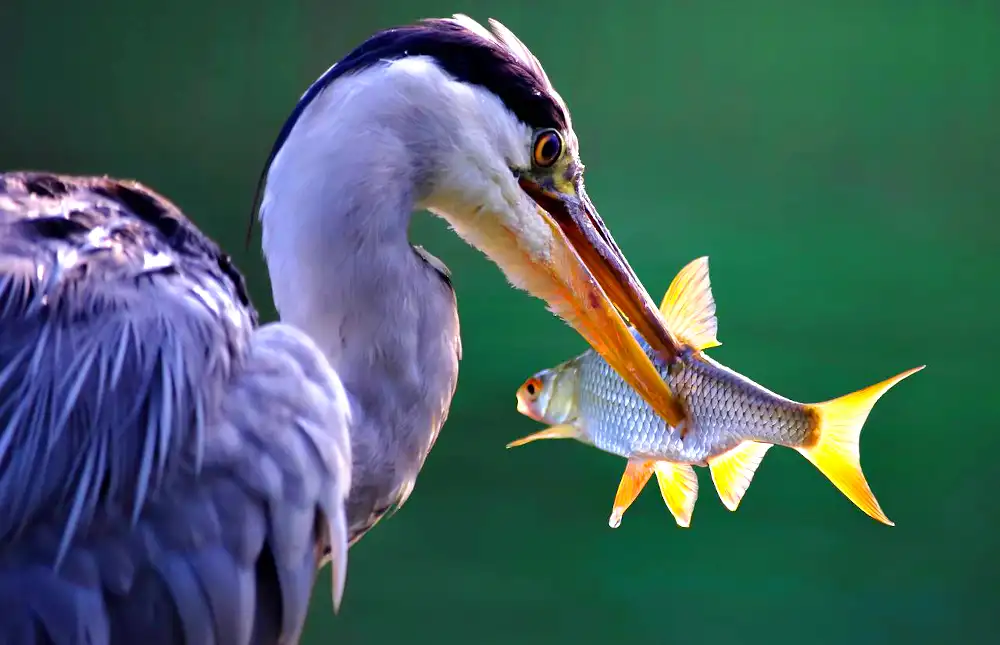
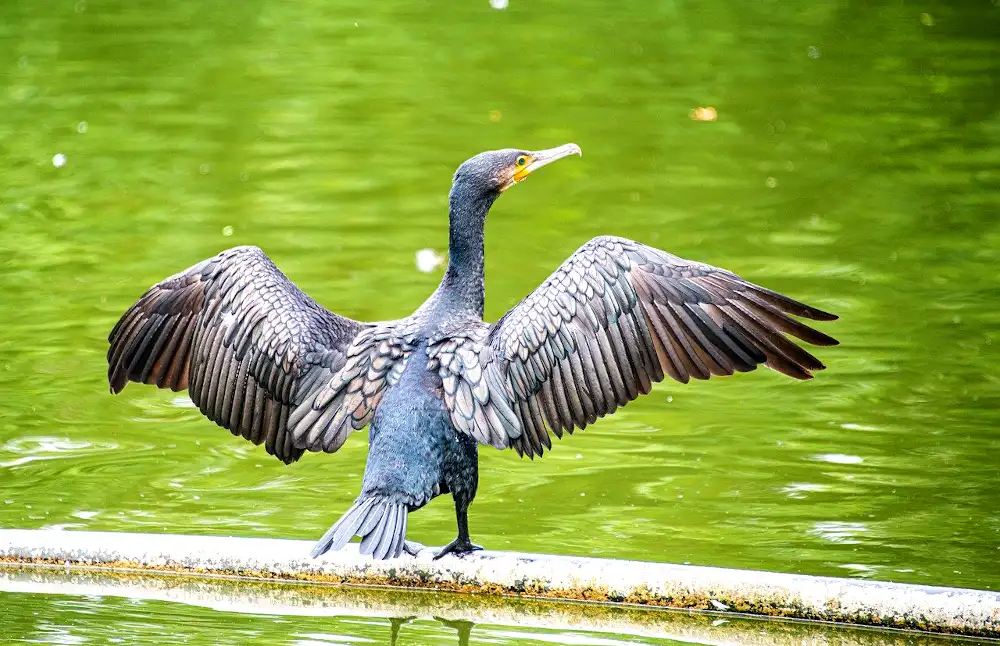
But it is not only birds that live in the water that find a new habitat here.
Songbirds can also be found near the shore and in the reeds. The pond warbler and reed warbler, the reed bunting and the bittern are especially worth mentioning here.
Creation of green islands, floodplains and wet meadows:
Of course, the measures of renaturation do not only refer to the course of the river. By changing the course of the river, one inevitably provides for the creation of islands, wetlands and floodplains.
In contrast to floodplain meadows, which depend on periodic river flooding and can also dry out during the course of the year, wet meadows are permanently wet and are fed from a variety of sources, including groundwater and rainwater.
These newly created areas also provide more habitat for birds:
Rusty and gray geese, which are particularly typical of the Lower Rhine, prefer the newly created floodplain meadows.
The lapwing, for example, is also dependent on wetlands for foraging and breeding. Of necessity, it is also satisfied with fields, where it can now usually be found on the Lower Rhine.
The lapwing is easy to recognize by its elaborate flight behavior and its penetrating long-drawn whistling call.
More information about the lapwing can be found at the following link.
Another bird that surely every hiker could observe at the Niers is the swallow.
The smoke swallow and the house martin depend on open and loamy soils for their nest building.
The swallow therefore benefits from the bank area, which was not originally planted with vegetation after the earthworks were completed, but was deliberately left as open raw soil in order to give nature the opportunity to establish the appropriate plants itself. This greening is called ruderal vegetation and it happens without human intervention usually by seed flight.
Here, too, pioneer plants are the first to settle down and contribute to the bank stabilization with their roots.
More biomass through land reclamation:
New plants settle on these areas over the years. As a rule, this begins with so-called pioneer plants, which prepare the soil, as these are particularly adapted to poor soils and have few requirements. They fix the soil and prepare it for subsequent plants.
Often, these plants are later partially displaced by other plants that permanently take their place. As a rule, pioneer plants provide help for the successor vegetation to grow, e.g. by protecting it from excessive solar radiation and enriching the soil with nutrients. Nitrogen depots and the humus layer created by leaf fall play a particular role here.
In forests, this stage is called preforest.
Usually, pioneer plants include red goosefoot, water speedwell, water mint, poplars, willows, alders, and many others.
Deadwood introduction:
The introduction of dead wood provides valuable refuge for insects, material for their nesting (e.g., wasps), and serves as elevation and perching for birds. The kingfisher, for example, has an optimal perch here to look for food.
Flood protection through renaturation:
Renaturation is also beneficial for flood protection. By widening and deepening the river and creating new side arms, the water level drops and the Niers is able to hold more water and the surrounding wetlands absorb more water.
Hand in hand with the renaturation of the Niers goes the renaturation of the sites of the former gravel dredges.
Renaturation of the dredge lakes around surrounding areas:
Around the Niers, various quarry ponds have been excavated on an area of approx. 40 hectares in recent decades as part of gravel mining.
These areas were renaturalized after dredging, partly by targeted measures and partly by leaving them to nature.
The result is now quite impressive, as a near-natural area has been created that has a lot to offer in terms of biodiversity compared to the typical arable monocultures of the Lower Rhine.
To take a closer look at the result of these efforts, we will take you on a short circular walk between Aspermühle and Kessel and embark on a short journey of discovery through the flora and fauna of the Niers and its surroundings.
Create Komoot tour
Round hike Aspermühle - Kessel - and back:
We start of course at the Aspermühle and find already here the first gem.
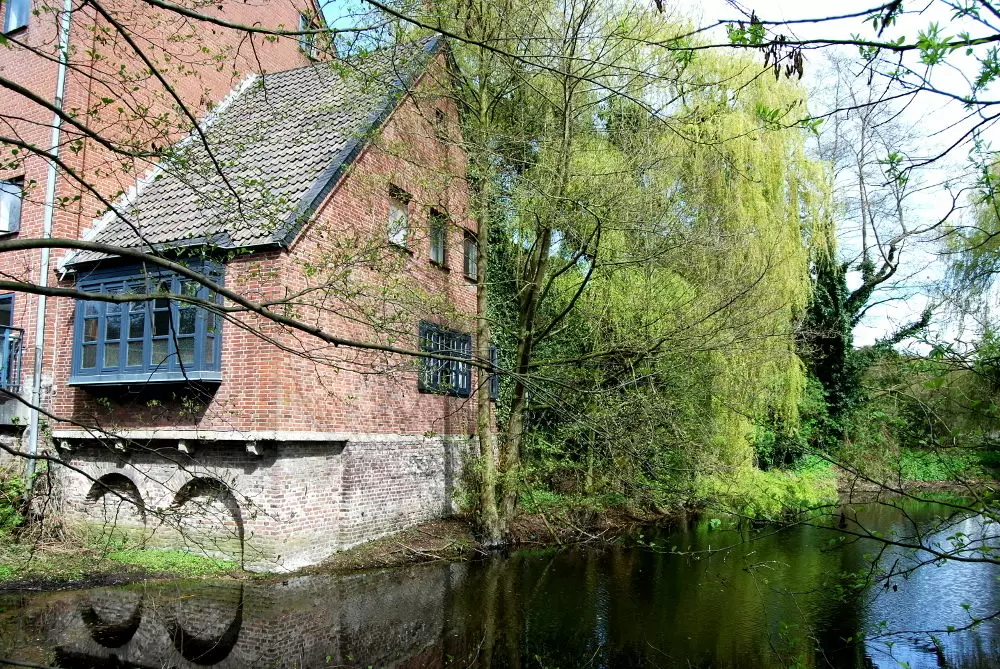
Aspermühle with pond
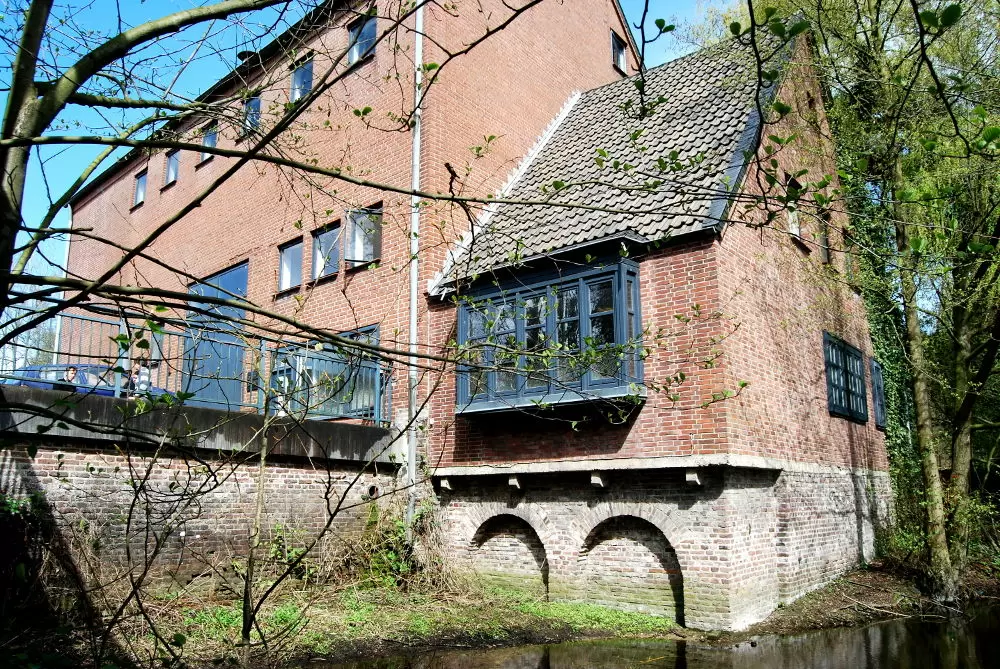
Aspermühle Hall
The mill pond, created after the straightening of the Niers, is surrounded by willows and is popular with ducks, coots, nutrias, herons and also the kingfisher. The small island in the pond regularly becomes a breeding ground for geese in spring.
A fallen willow offers shelter to small creatures.
The Way of St. James leads us first to the left of the Niers in the direction of the Graefenthal monastery.
You can also explore the Niers by boat, but in this case you should refrain from loud music and alcohol consumption, because this has nothing to do with a respectful treatment of nature !
Already after a few meters you can make the first discoveries.
To the right hand, after a short time, you will find a dead side arm of the Niers, which offers shelter to various water birds due to its penetrated woody growth and the abundant dead wood. At night you can hear the nightingale singing in this area, which feels most comfortable near the banks and in bushes.
The first exciting representatives of the fauna are also not long in coming.
Valerian, nettle and elderberry - medicinal plant, superfood and summer refreshment:
These three plant species can be found again and again on the banks of the Niers and they are probably known to everyone.
The valerian (lat. Valeriana officinalis) has been used as a medicinal plant against insomnia and restlessness since the time of the Greeks and the Romans.
Even nowadays valerian extracts are prescribed against sleep disorders. The active ingredients are the so-called lignans.
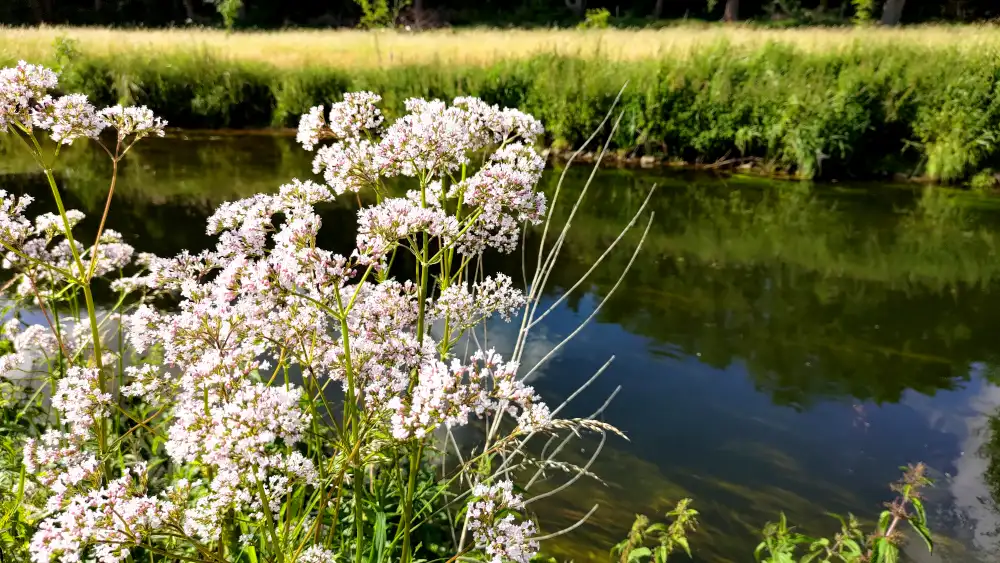
Valerian blossom
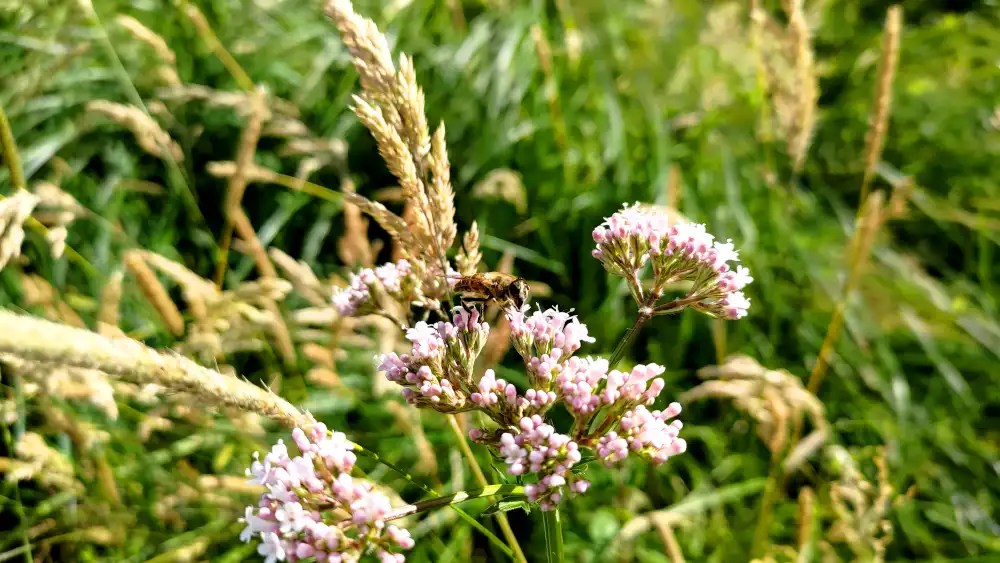
Valerian flower with visitor
The strong scent of valerian flowers, somewhat reminiscent of lilies, can be perceived from afar and, when you step closer, gives off the almost unpleasant smell of valerian root.
For bumblebees and wild bees, valerian is a rich source of pollen from June to August and is readily approached by them.
The stinging nettleloved and hated. Everyone has probably encountered the stinging nettle at some time or other. The fine hairs of the stinging nettle contain formic acid and are so brittle that they break at the slightest contact with the plant. The effect probably does not need to be described in detail here.
As unpleasant as an encounter with stinging nettle can be, its benefits to humans and animals are great.
The stinging nettle is a wares superfood. Dried, 100g of the plant contains between 20-25mg of iron, about 450-500mg of magnesium, 3000-4000mg of calcium and 2500-3000mg of potassium.
It can thus contribute a considerable amount to the daily supply of minerals and trace elements.
Since it also contains almost 900mg of vitamin C, the iron it contains is excellently utilized and there is no need for an additional vitamin C supplement.
Of course, stinging nettles also have their uses in nature. For butterflies they are virtually indispensable basis of life.
On the one hand, a variety of different butterfly caterpillars (see photo) feed on stinging nettle leaves, such as the peacock butterfly and the admiral. On the other hand, there are some species of butterflies, such as the small fox and the country cactus, which lay their eggs only here.
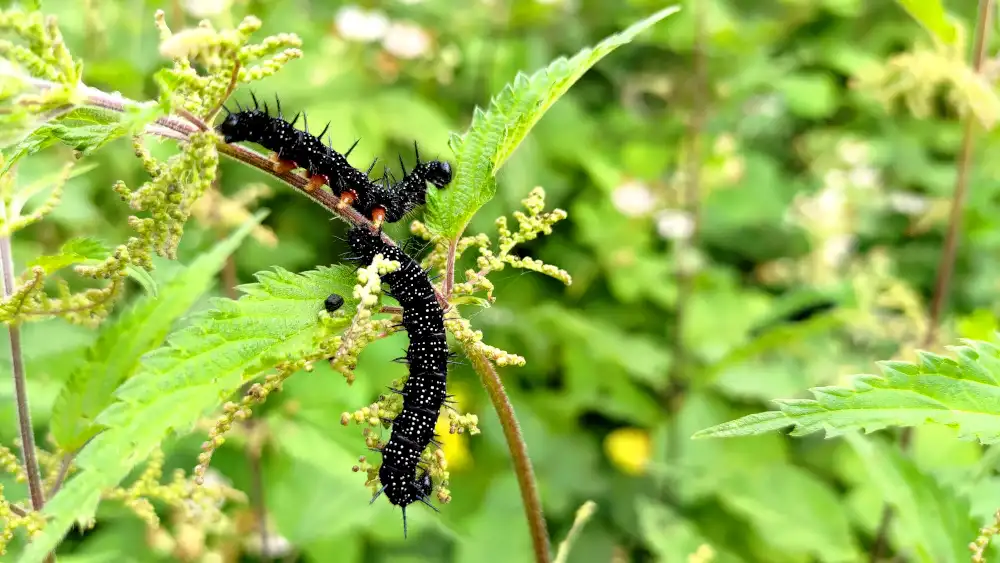
Nettle with caterpillars
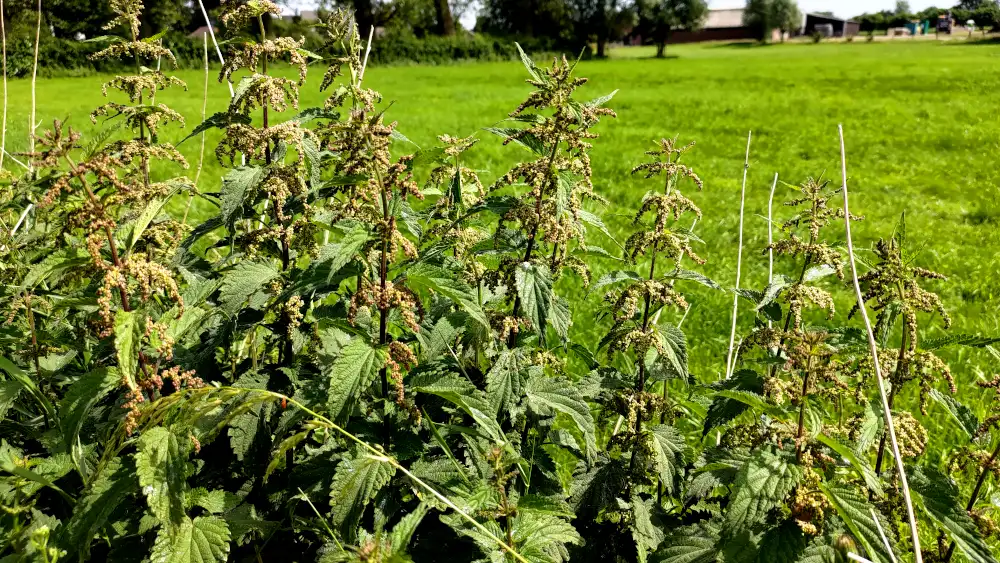
Nettles
So the next time you mow your yard, remember to leave a small corner of stinging nettles for the butterflies. They will thank you for it.
The first elderberry bush The stinging nettle can be found directly on the left side of the horse meadow after the large linden tree (a section on linden trees will follow later).
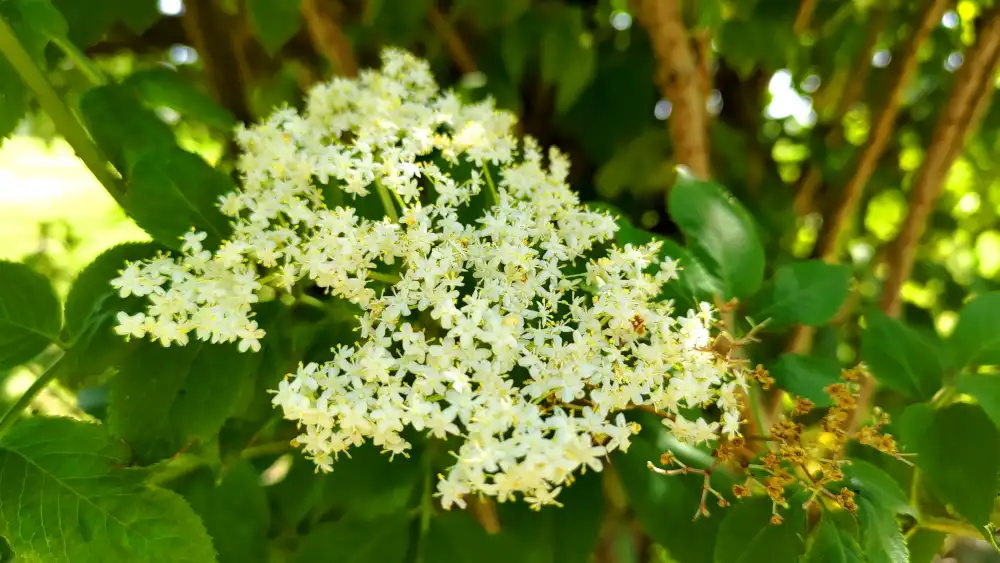
Elderberry blossom
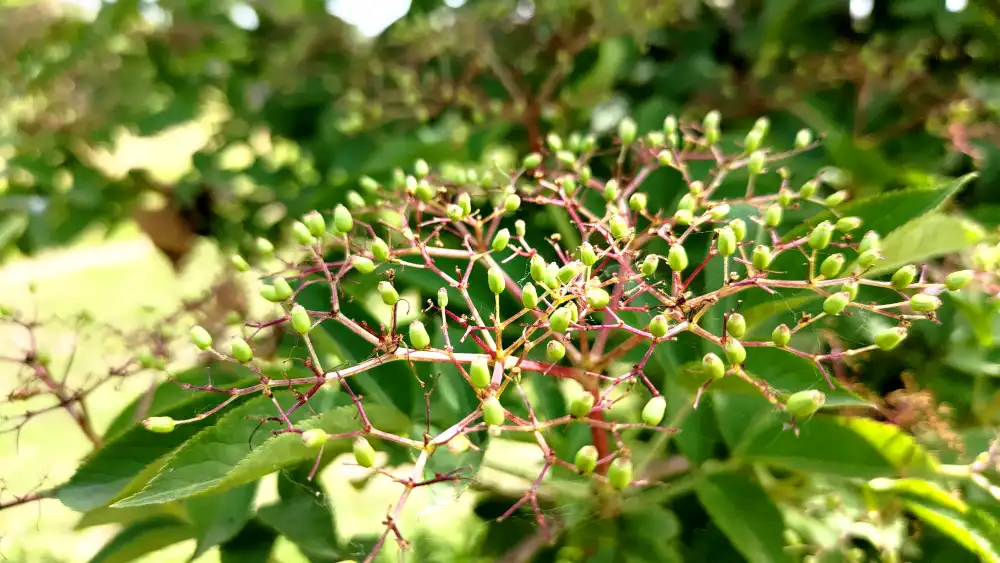
Unripe elderberries
That you can process both the flowers and the elderberries wonderfully is certainly sufficiently known.
From the blossoms you can make a very tasty syrup, which with a little mineral water makes a wonderfully refreshing summer drink. You can find a recipe for this in our blog article.
The berries can be made into delicious juice or even jelly. You can find a recipe for this in our DIY section starting this fall.
If we now continue walking we see to the right hand the Reichswald, which looks over to us from the Lower Rhine ridge and to the left hand in the distance(you have to search a bit) a stork nest. With a little luck, the storks can also be seen on the adjacent pasture during their search for food.
Directly perceptible are also the swallows in the summer, which turn your rounds over the Niers and snatch insects from the air.
We pass a group of black alders, which as birch plants are optimally adapted to damp-wet locations, and reach the first junction of our hike.
In summer and autumn you now turn left and walk the regular hiking trail. In winter and early spring you have the possibility to walk to the right of the bank, straight ahead along the Niers.
This path is usually not passable at other times, because it is either flooded or overgrown. It is also a bird breeding area and should not be disturbed at a later time.
If you are lucky and the path is passable, you will find yourself between the quarry pond and the Niers and have the opportunity to make some very nice nature observations.
Here you should walk especially carefully, because there are a few special features that you can only see if you walk quietly and carefully.
Among turtles, beavers and bisams
Especially worth mentioning are the turtles that like to sunbathe on tree trunks lying in the water when the weather is nice.
However, they are extremely shy and dive into the water at the slightest noise.
So if you want to observe the turtles in the lake, you really have to walk on very quiet soles.
The next candidate, which is usually difficult to see, is the beaver. Being crepuscular/nocturnal and also very shy, few people have probably seen theirs in the wild.
But what you do get to see are the beaver's gnaw marks, fallen trees and also the so-called beaver slides.
These are the paths of the beaver along the shore into the water. Since the beavers usually use the same route, at some point a muddy path is created here on which it is especially good to walk and transport logs, which thus slide into the water more easily.
The myth that the beaver supposedly slides down the slope on its tail is quite a pleasurable notion, but probably has nothing in common with reality.
Since the beaver's tail is scaly and used for locomotion in water, it would tend to slow down when trying to slide down the slope on it.
Another observation that can be made is the piles of shells all along the trail. These are the remains of a gourmet meal of bison.
Although bison live mostly vegetarian lives, they like to add some variety to their diet from time to time by spicing it up with insect larvae, crabs and clams.
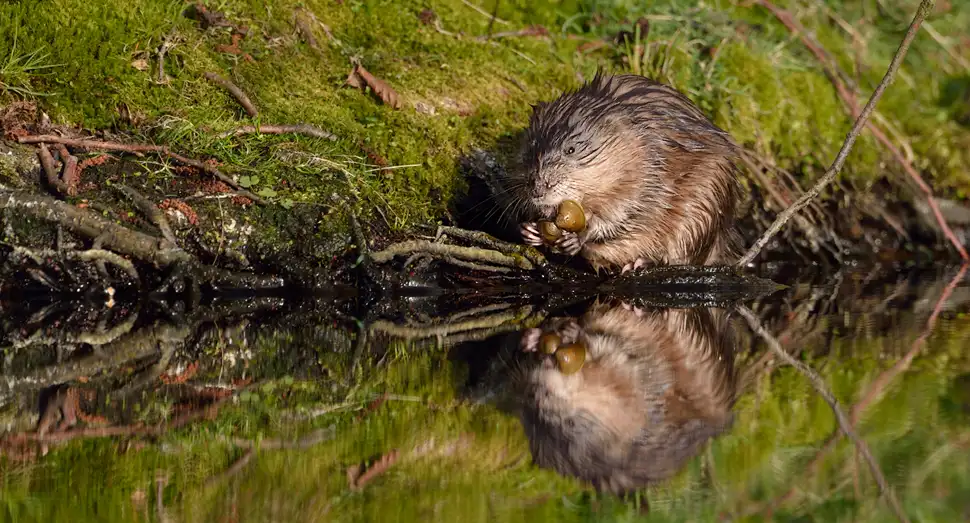
Photo: Gordana & Ralf Kistowski / www.wunderbare-Erde.de
Along the way a cormorant appears from time to time on the river side and the Great Crested Grebe on the lake side.
These two contemporaries are also very shy and can therefore usually be observed from a distance. Likewise it behaves with the everywhere to be found heron.
But we turned left and follow the hiking trail. Here we find now directly the elder again, which is partly overgrown here by wild hop.
Hops belong to the hemp family. Its aromatic cones are ready for harvesting in late summer/fall. Both the hop shoots and the ripe cones are suitable as food.
The ripe cones can be used to make a wonderful aromatic bedtime tea.
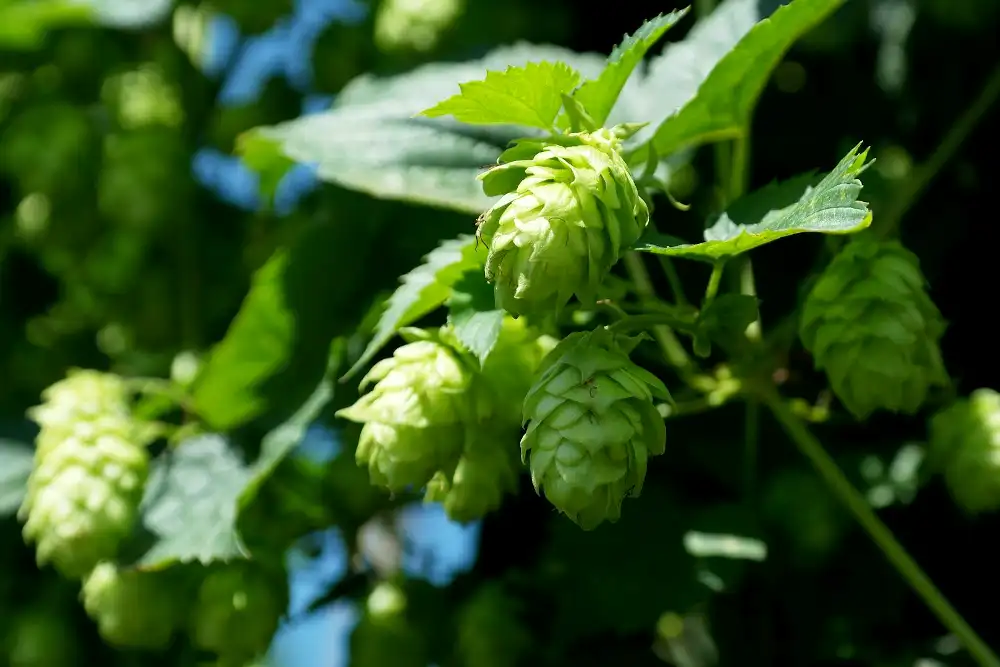
Hops
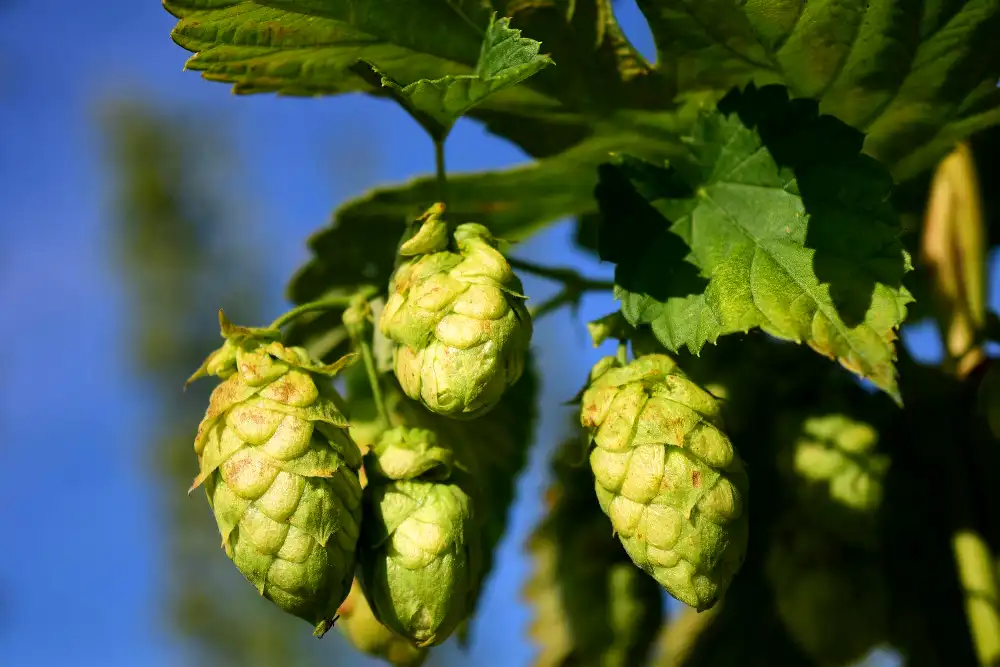
by turning right again at the next opportunity.
From here on you always have the possibility to reach the lake on small paths. There are some idyllic places that invite you to linger. If you often notice a fresh minty smell, don't be surprised, because water mint has settled around the quarry ponds.
You can use the water mint to prepare it as a tea, but it is much less aromatic than other types of mint.
So now we have the large quarry pond on our right hand and the small quarry pond with renaturalized riding area on our left hand.
The renaturation is bearing fruit:
A lot of effort was put into the renaturation of the riding area. It was planted with various native woody plants, such as sloes, rowan, wild roses, hazelnut, hawthorn, etc..
A blog article on native woody plants can be found at the following link.
It thus provides both habitat and food for birds and insects. It also screens the interior lake from the outside, providing quiet for waterfowl.
Various pioneer plants, such as willows, poplars and alders have also established themselves there. In addition, evening primrose, the Greis and St. John's wort and, at the edge of the forest, foxglove can be found in abundance on the site. So it fits in very nicely with the rest of the surroundings.
Also to the right hand, one can clearly see that the renaturation efforts are bearing fruit. On the one hand, a decent stock of trees and shrubs has built up there in recent years, consisting of oaks, hazel, poplars and willows.
On the other hand, the deadwood left there from felled or fallen trees shows how valuable this is as a habitat.
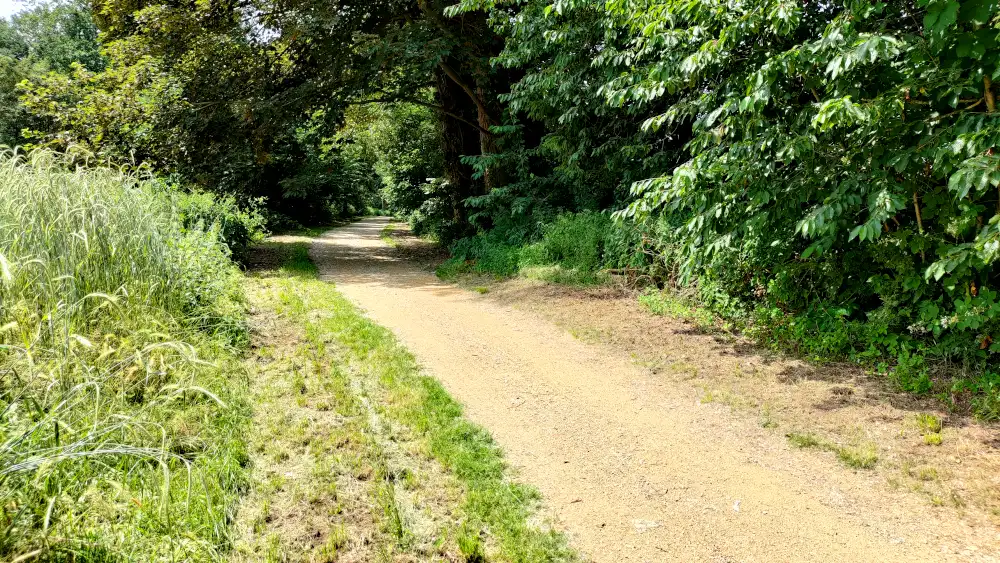
Niersweg
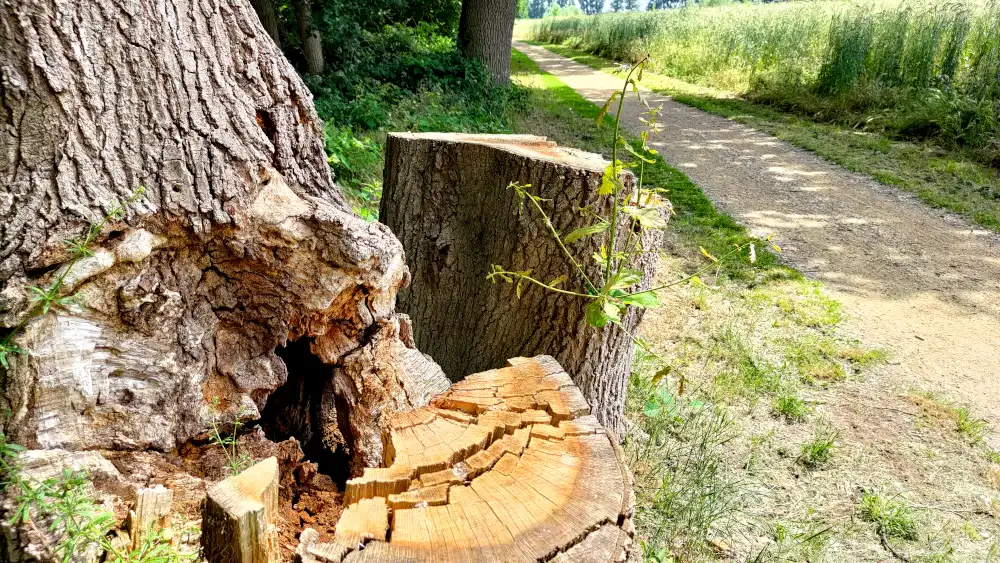
Niersweg with deadwood
Directly at the end of the riding area, there is the stump of an old poplar tree with a tree hollow at the side of the path, in which a hornet colony has taken up residence. This is no reason for alarm, because hornets are very relaxed and peaceful animals that have no problems with people, horses or dogs. On the contrary, they are even rather conflict shy.
They are also not interested in human food, unlike wasps that like to snack on coffee cake.
They feed on nectar and tree and fruit juices and on insects they prey on. These include mainly flies, dragonflies, wasps, beetles and caterpillars.
So you can easily observe the hornets from a few meters away. The flight behavior is quite interesting.
You can find more information about hornets in this NaBu brochure.
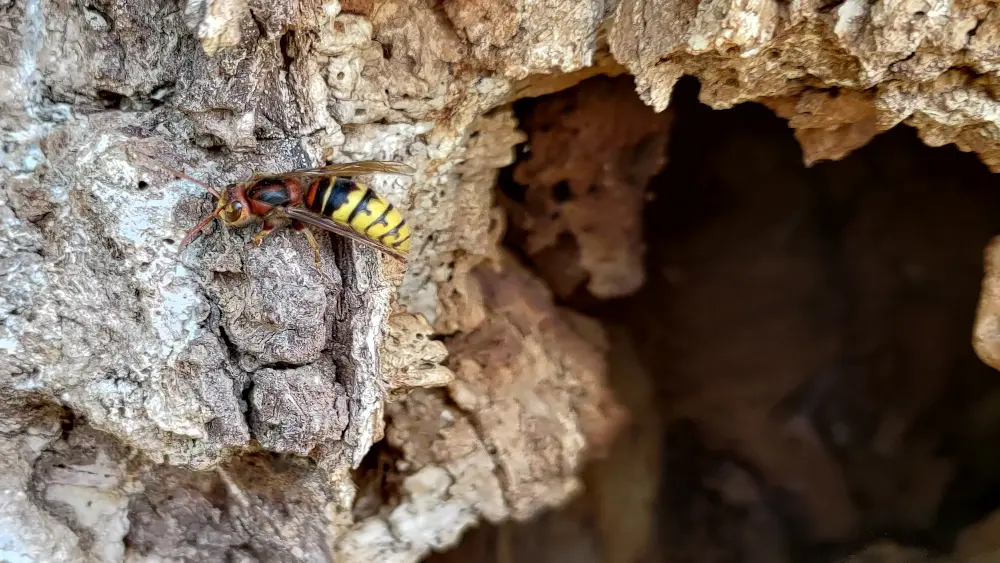
Hornet
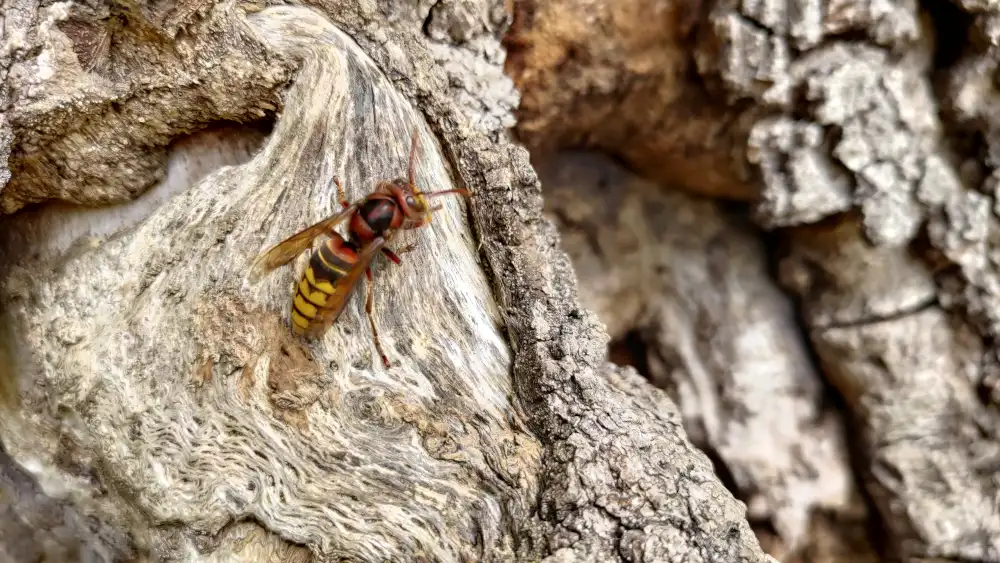
Young hornet
Since hornets are highly endangered, they are under nature protection.
Therefore, the intentional or negligent killing of hornets is not allowed. Destroying hornet nests is also prohibited and can result in criminal proceedings. Should you violate these regulations, depending on the federal state, fines of up to 50,000 euros or prison sentences of up to 5 years can even be imposed.
So please treat the animals respectfully !
If we now continue walking, we quickly come to a small grove and the first foothills of the monastery wall of Graefenthal.
In the grove you will notice the ivy that grows on the trees. First of all, you have to be careful with the ivy, because it is poisonous. Since it produces dark blue to black berries that can tempt children to eat them, parents in particular should be careful.
Ivy can also cause damage to trees, especially when they are smaller. Here it can overgrow the crown and then trees thus take the light to grow. As a rule, however, it cannot harm large trees.
However, one should not demonize ivy too much, because it has its uses and its raison d'être.
Especially as a nutrient plant for insects and birds, the ivy should be emphasized. The late blooming period between September and October is of great benefit to many insect species. The resulting fruits ripen in winter and serve as welcome winter food for birds, which can easily tolerate them due to their complicated digestive tract.
More detailed information can be found at the following link.
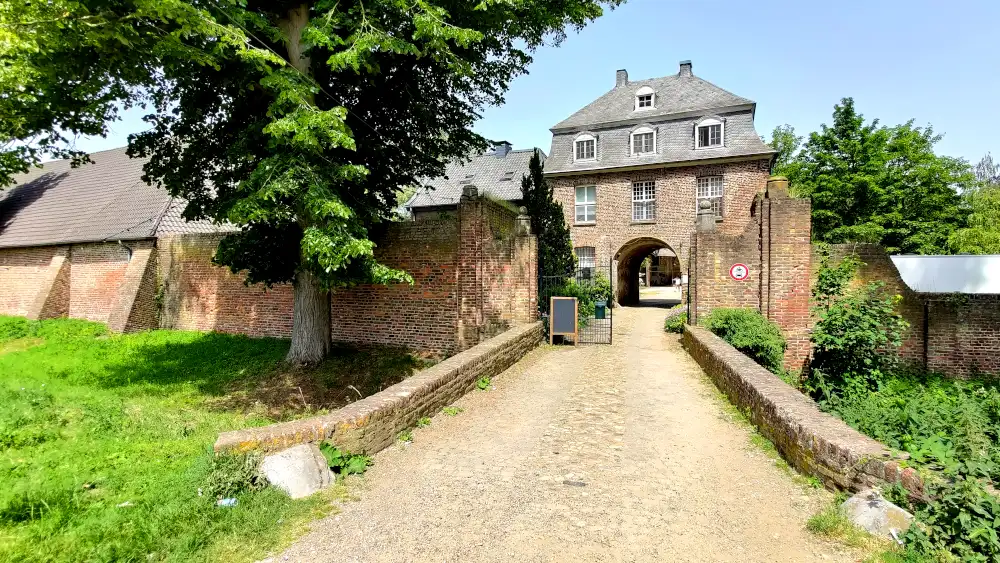
Graefenthal Monastery Gate
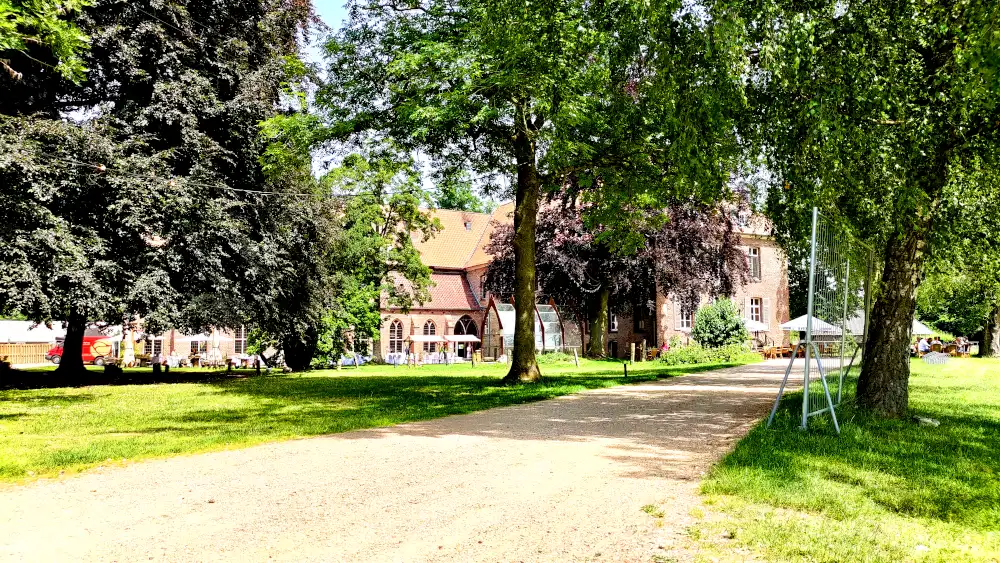
Graefenthal monastery inner courtyard
Graefenthal historically connected with the Aspermühle:
We have now arrived at Graefenthal Monastery. The monastery and the Aspermühle formed a unit in historical times. You can find more information in our article "The Aspermühle through the ages".
The monastery was founded in 1248 by Count Otto II of Guelders and was a women-only monastery.
It originated from Rott Castle of the knight Stefan von Pleeze and was built in the then modern Gothic style. The high grave of Otto II can still be found in the courtyard of the complex and can be visited.
The site existed as a monastery until 1802 and was dissolved during the Napoleonic secularization and sold to the Sinsteden family, who continued to use the complex as a farm.
In 1987 the city of Goch took over Graefenthal. Later it was sold to Ijsbrand Roovers, who had it restored with the help of a support association. Since then it is open to the public again.
The courtyard is well worth a visit. It is a very picturesque estate with a cafe that invites us to linger and, with a view of the old walls, the free-roaming peacocks that can be heard from afar, and the large trees with shady spots underneath where chickens and their chicks scramble for food, gives us an impression of how life might once have been here.
Linden trees a scent magnet for people and insects:
When you leave the monastery again, you will see a group of large old linden trees on your right, whose pleasant fragrance can be perceived from afar when they are in bloom in June. The summer lime trees are a real magnet for insects and if you go closer you can clearly hear the buzzing.
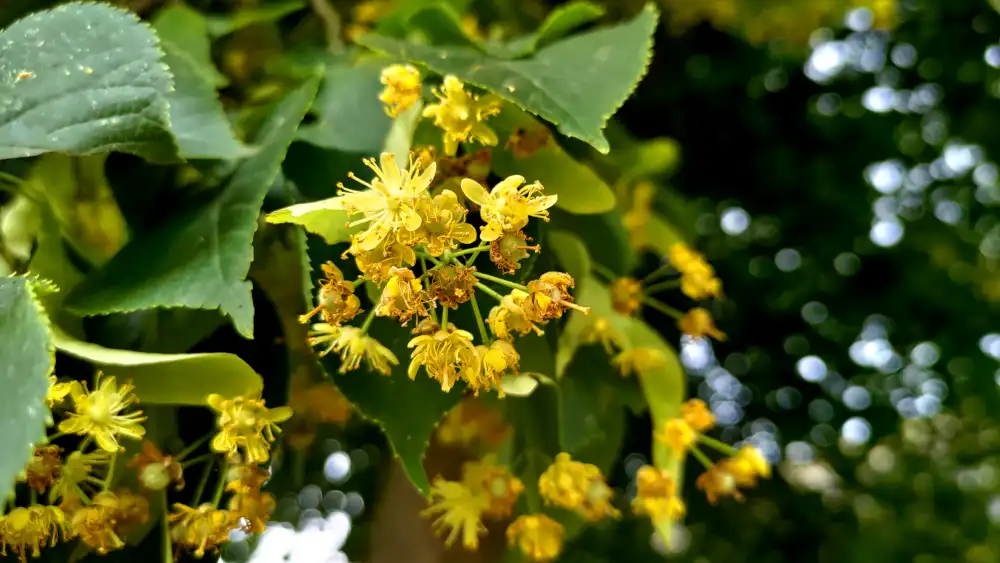
Linden blossoms
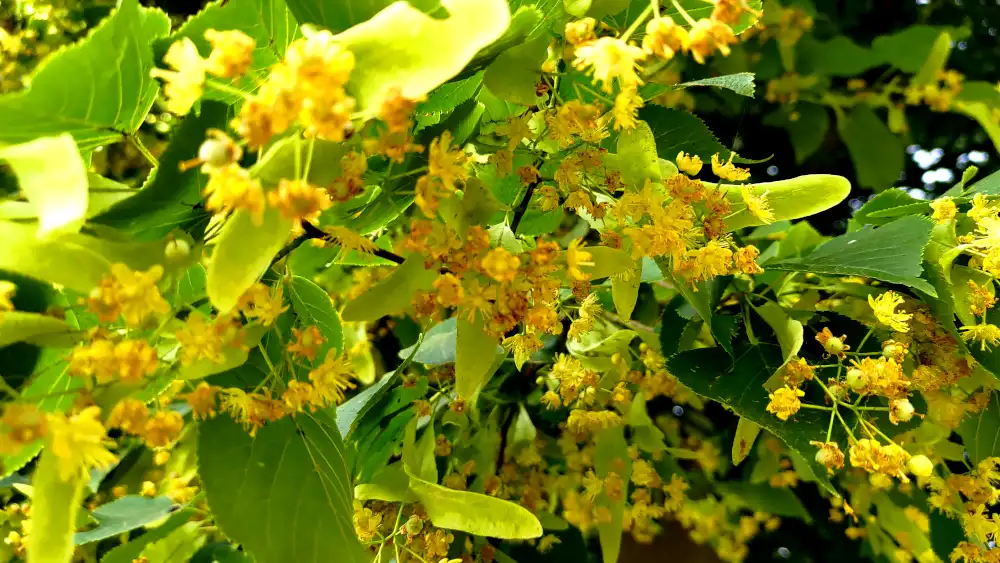
For some time there has been a rumor that the nectar of the lime tree could be poisonous for bumblebees, because there is probably always the phenomenon of mass bumblebee deaths under lime trees.
However, this is not the native lime tree, but the silver lime tree. But also their nectar is not poisonous. It is probably more a case of bad timing. The silver linden flowers towards the end of July, a time when, due to a lack of flowering meadows and gardens and agricultural monoculture, there are few other flowering plants.
Thus, all the bumblebee colonies and other insects in the area are magically attracted to the silver lime trees.
Unfortunately, the nectar supply of the trees is then no longer sufficient to satisfy the large number of visitors.
Since, in contrast to the honey bee, other insects do not build up honey stocks, they unfortunately starve miserably.
To remedy this situation, everyone can make a contribution by transforming their barren gravel garden into a flower paradise that bumblebees love to fly to.
Honeybees also naturally feed on linden trees, producing the incomparably aromatic linden honey.
For insects the lime tree blossoms are one of the food bases. For humans they produce a tasty tea, which, enjoyed with honey, has a pleasantly calming effect before falling asleep.
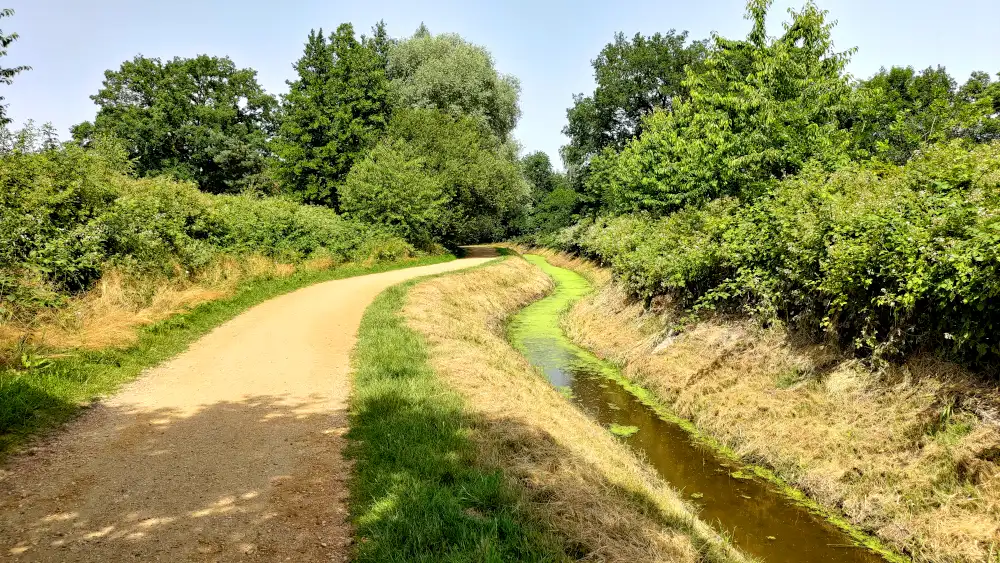
Puttenbruch
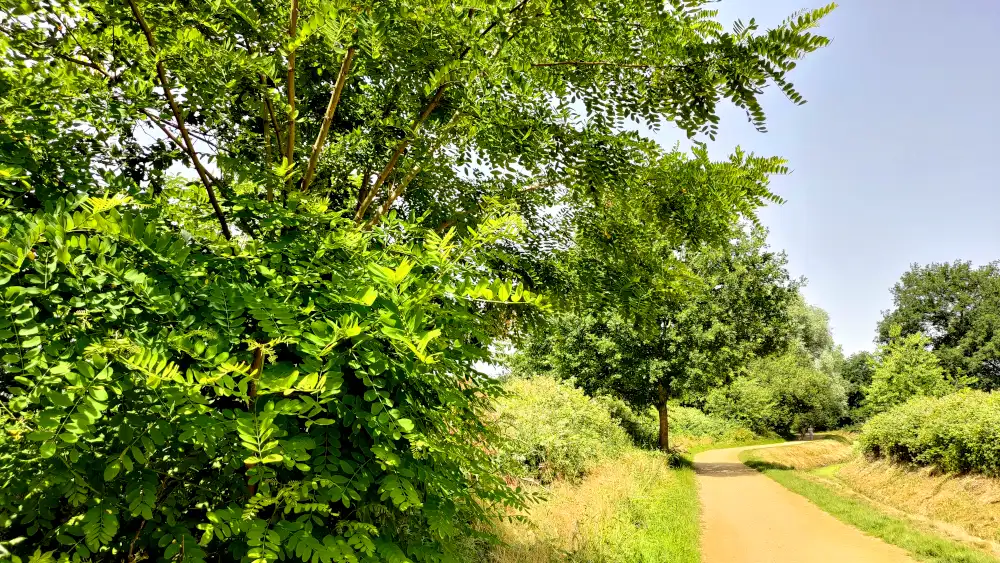
The further path leads us away from the monastery wall and along the Puttenbruch ditch. Here you can find the best blackberry bushes on both sides of the path. With enough water, sun and diligent bumblebee pollination, large fully ripe fruits grow here in summer.
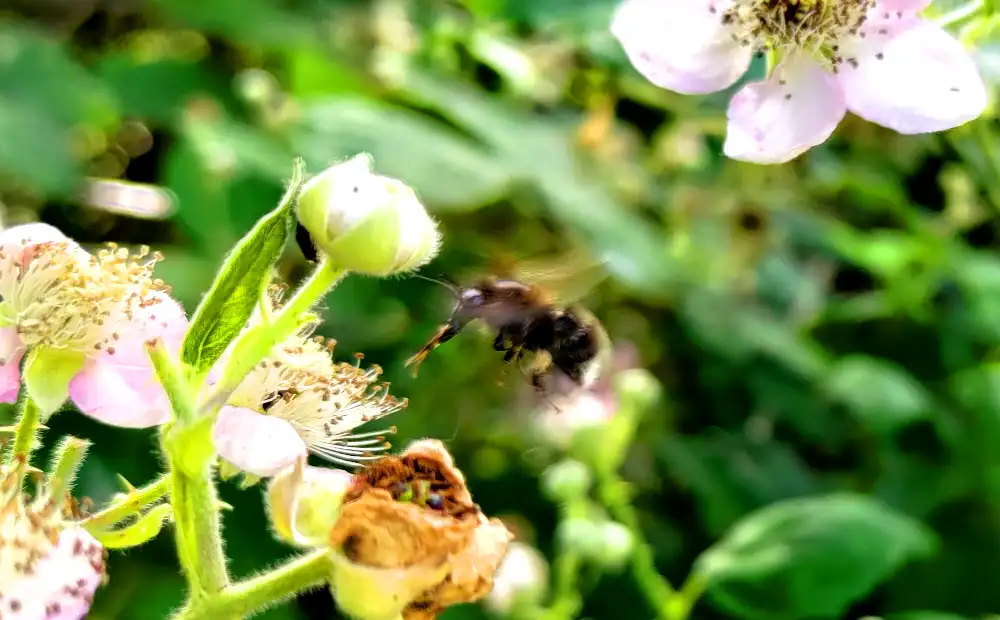
Bumblebee at raspberry blossom
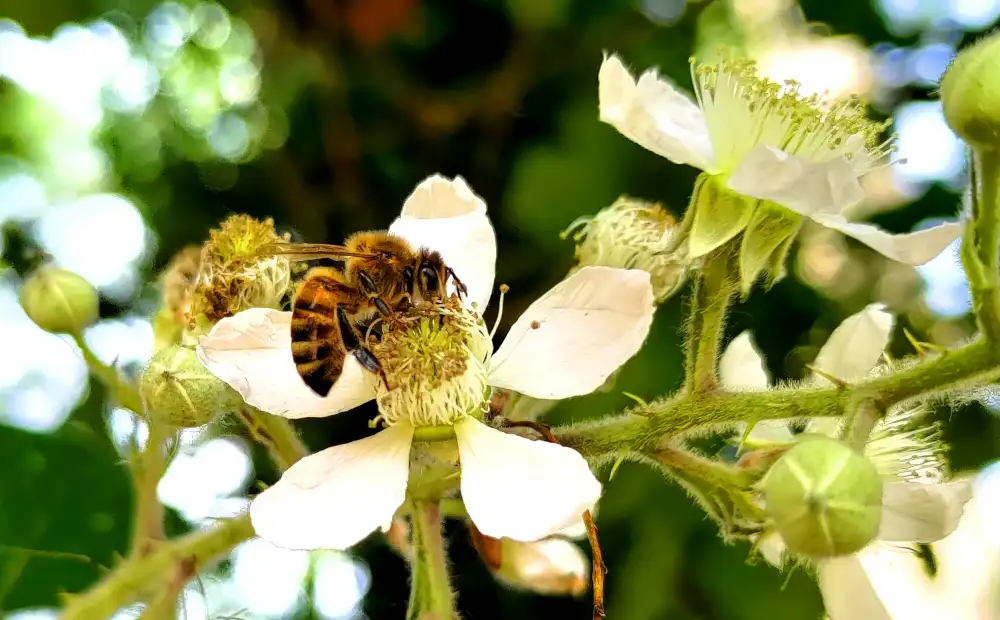
Bee at raspberry blossom
Arriving at the next waypoint, we turn right again so that we have the lake on our left hand.
A Lower Rhine sandy beach invites us to linger:
Again, we are in a landscape conservation area. A correspondingly respectful treatment of nature should therefore be a matter of course.
You have here several times the opportunity to penetrate on winding paths to the lake and you will be rewarded for it, because here you will find a small sandy beach and clear lake water, which invites you to swim.
However, pay close attention to the path in mid/late June, because during this period it is usually littered with tons of little mini frogs. This is an indication that spawning is undisturbed.
The sand was flushed up here after dredging to create more land area again.
Nature was able to recover and has thanked it with the establishment of a pine grove, alders and willows. In the meantime, a fish population can be found in the lake. Due to the good water quality, fish such as the pike, perch, zander, rudd, roach and eel can be found here.
The area is leased by the anglers' association and may still be entered by walkers. Unfortunately, visitors and especially barbecuers like to leave their trash here. This does not go down well with nature lovers.
We are now not quite halfway there, but since it is really very picturesque here on quiet days, we linger briefly and enjoy a little vacation feeling, then set off for our next waypoint.
At this fork, it doesn't really matter whether you go left or right, because we eventually come out at the same point. The left path is a bit longer, but has the advantage that you can see a terrain to the right that was originally used intensively for agriculture, but then was given over to nature.
We go the next possibility on the right and shortly after again on the left and follow with it again the Nierslauf and are now not far away from the renaturalized area. Before we get there, however, we will see the first large reed zone on the left side.
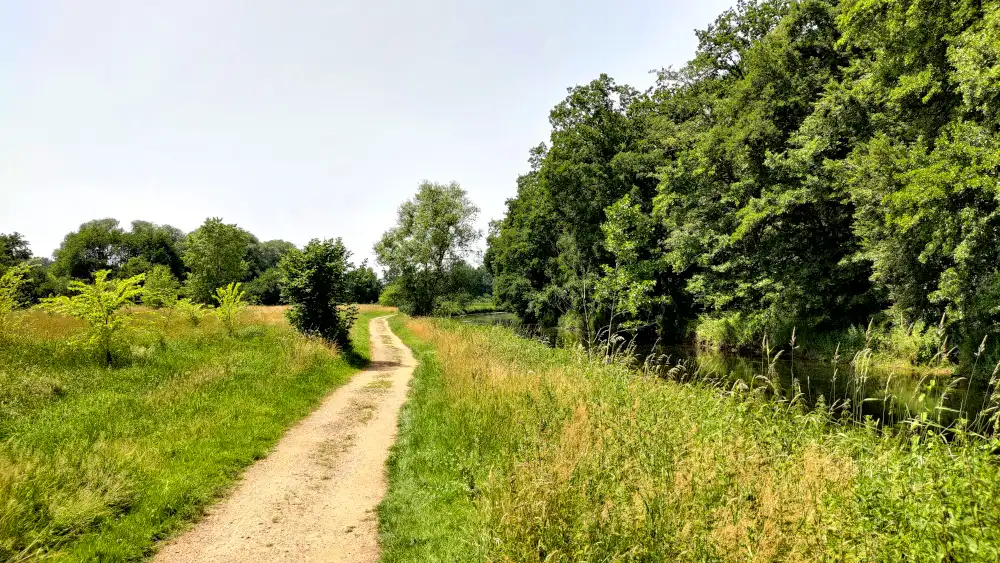
Niersweg
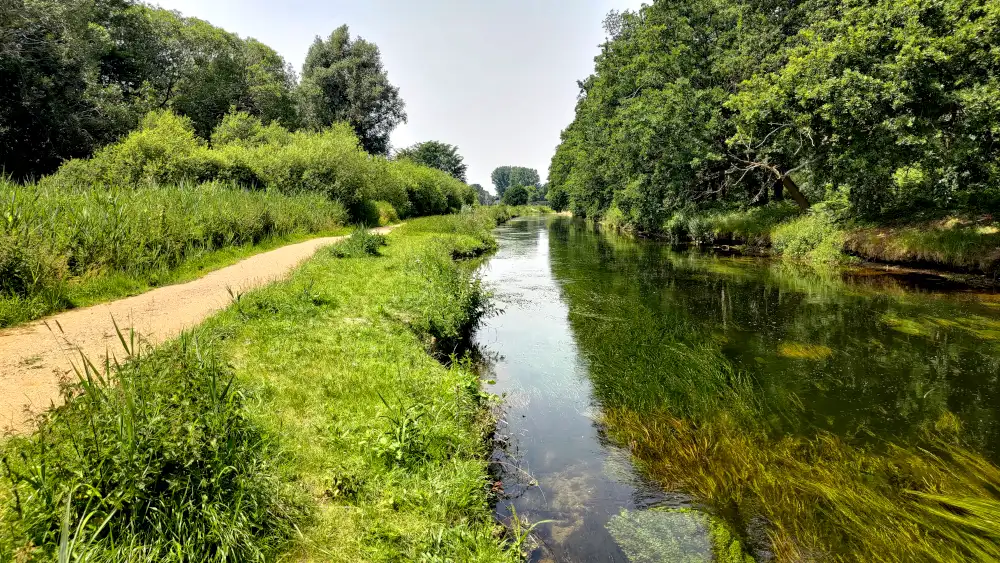
Jakobsweg
We are now again between the Niers and one of the quarry ponds. This area is usually flooded in spring and then often impassable for a while, at least for humans. Dogs usually do not mind. :)
Neptune with insert. Asperden domestic dog breed.
Renaturalized Niers area:
Shortly thereafter, we finally reach the restructured Niers area. The result is clearly visible. Since 2019, the originally unvegetated area has experienced proper growth. Many pioneer tree species, such as willows, alders, poplars and birches have settled here, as well as wild herbs, such as common viper's bugloss, buttercups, forget-me-nots, meadow daisy, purple loosestrife, evening primrose and marsh iris. Thus, within only three years, the area has independently transformed into a valuable ecological biotope.
The side arms and the islands created by them were gratefully accepted by waterfowl. Swans have come to breed there and raise their offspring.
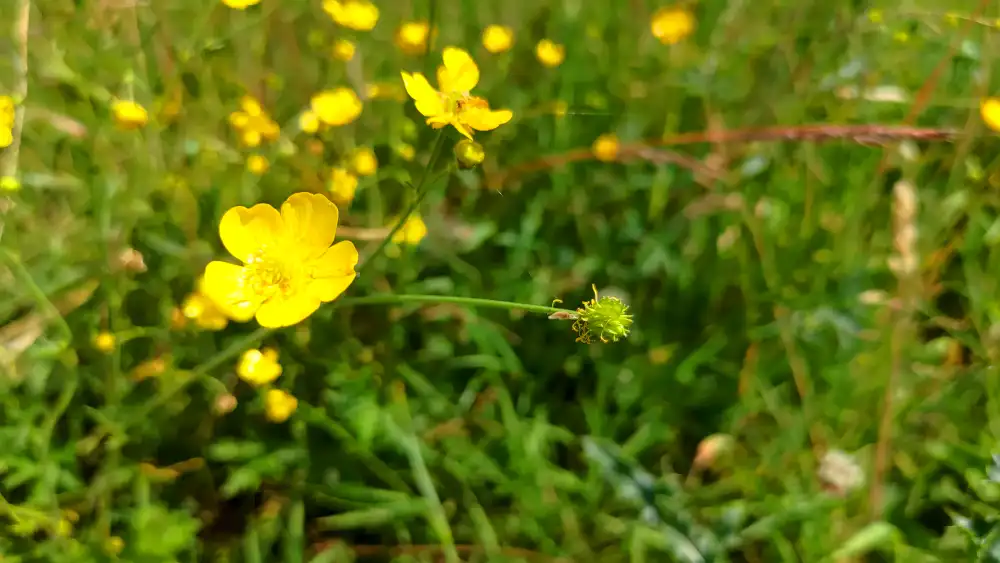
Aspen mill with pond
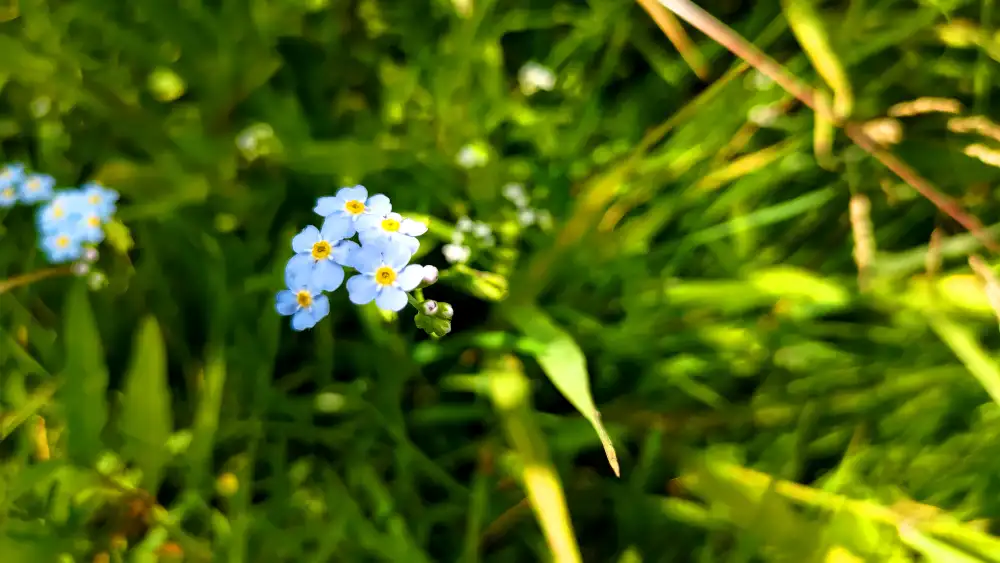
Primrose
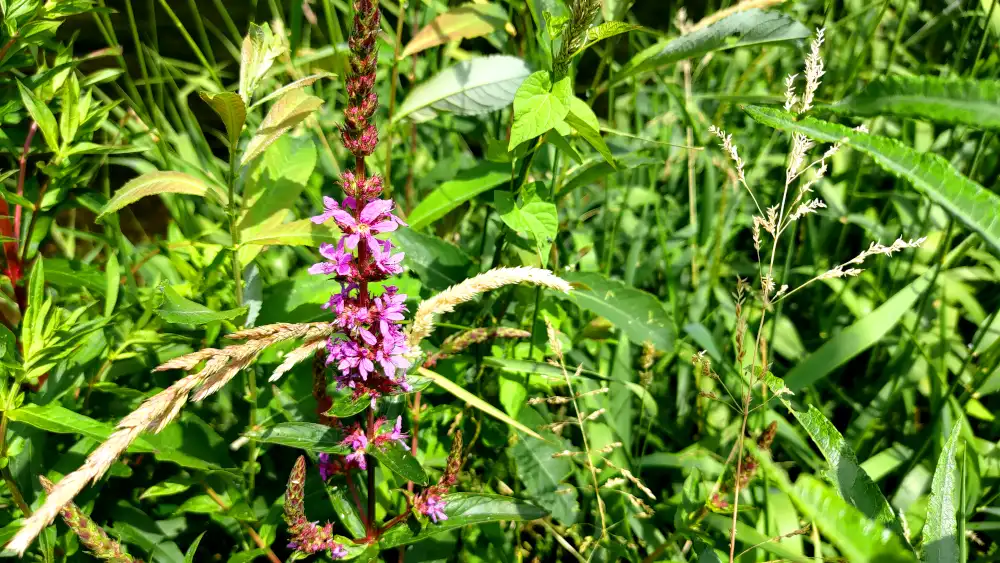
Purple loosestrife
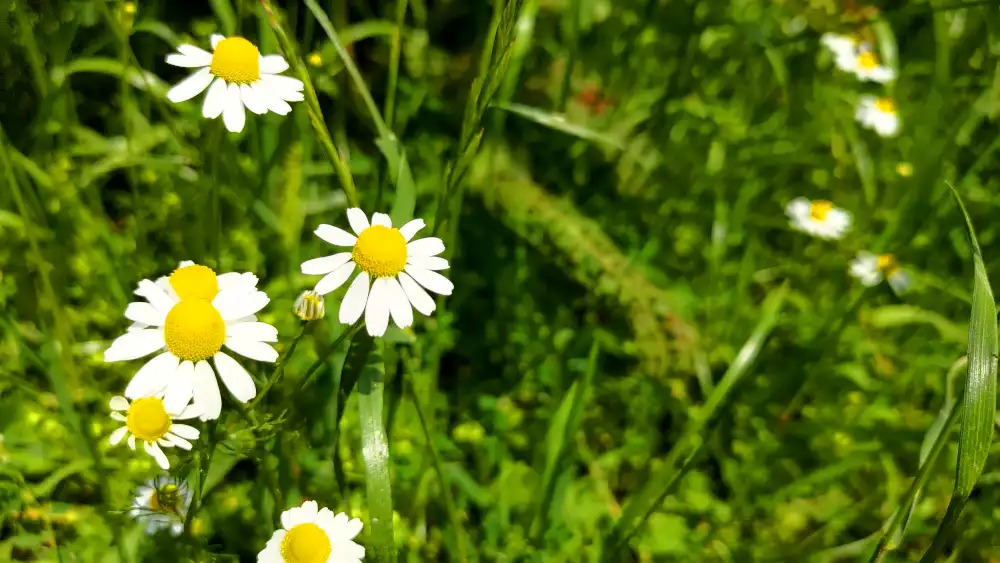
Marguerite
More birds
Also another reed zone can be found here now ????????.
Various wooden benches invite you to linger here.
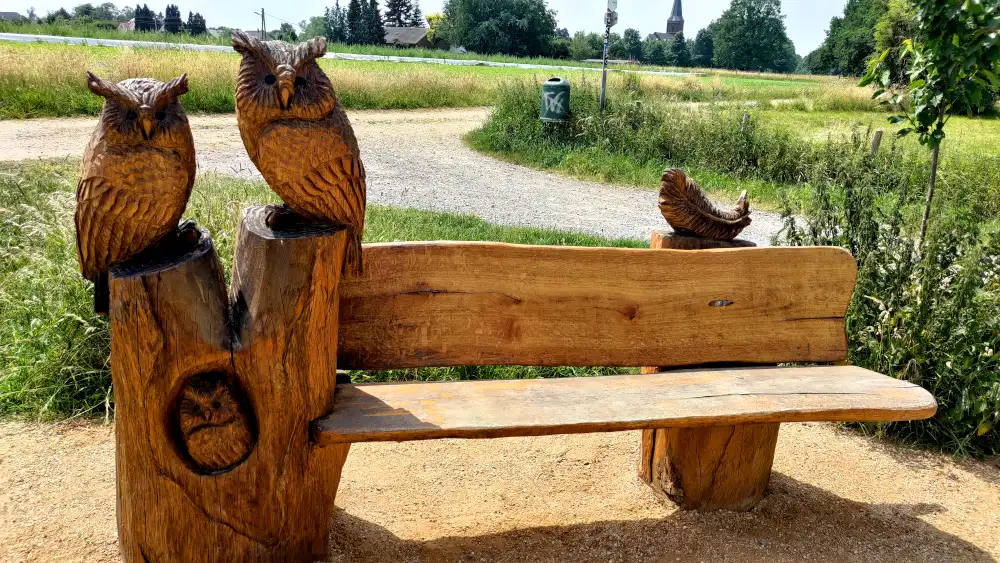
Carved bench with owls
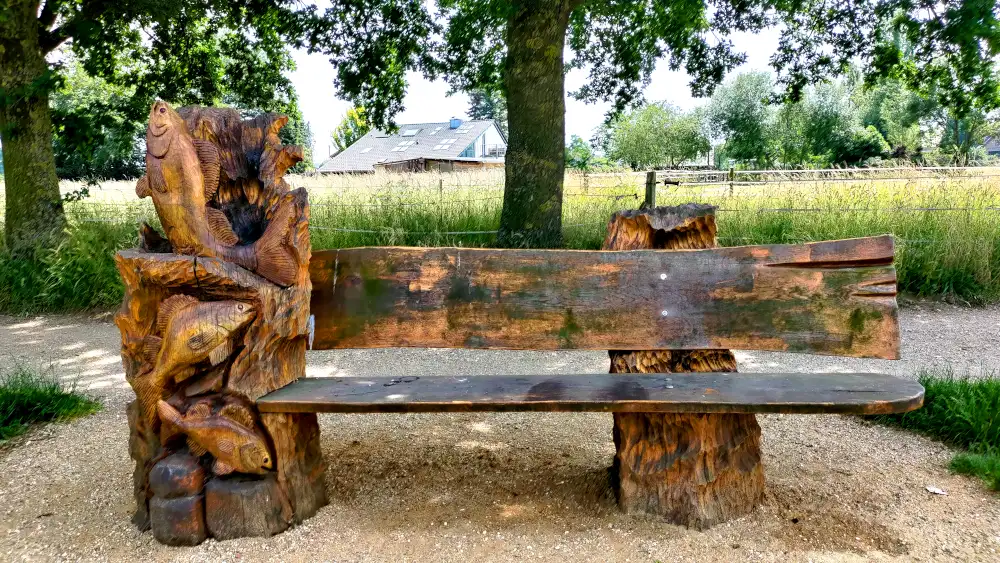
Bench with fishes
The renaturalized area stretches over 3 sections. One to the left and one to the right of the path and the third area is reached by following the Niers downstream, behind Kessel.
If you walk to the left of the Niers, you will pass through the village of Kessel, which can be seen from afar with its church tower.
But also walking on the right side of the Niers has its charm, because you pass the donkey farmer. This farmer also offers donkey walks. This is great fun, especially with children. You don't need to know much about the area, because the donkeys usually know their way.
In the distance you can see the church tower of Kessel.
We now cross the Niers bridge, which offers another good view of the renaturalized area on both sides, into the cool Reichswald forest and walk right of the Niers upstream back towards Aspermühle.
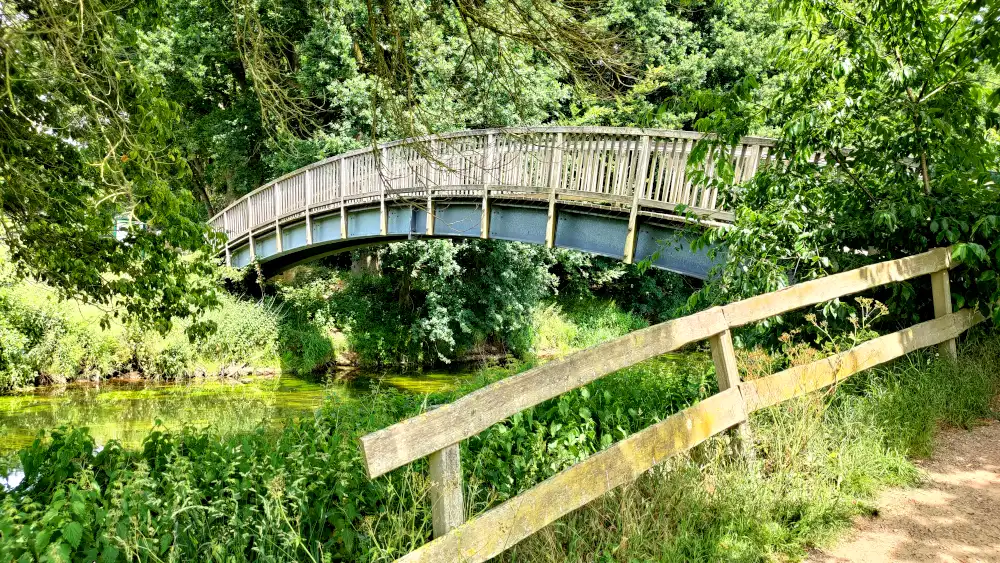
Niersbruecke Kessel
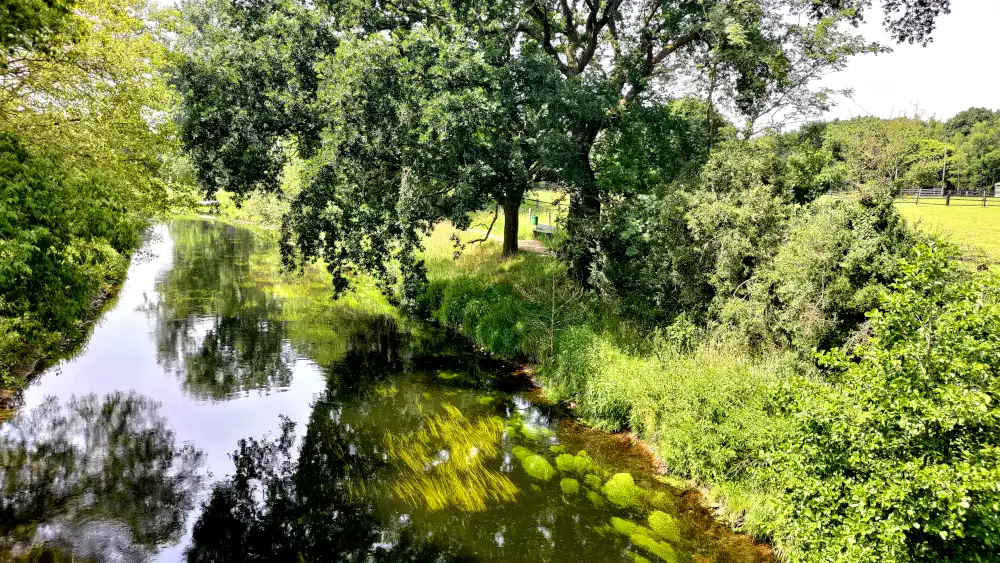
The Reichswald a historical review:
As described at the beginning, the Reichswald is located on the Lower Rhine ridge and is the largest contiguous forest area on the Lower Rhine.
The Reichswald has also suffered greatly from human influence in the past decades.
During World War 2, large parts of the forest were destroyed by shells and bombs in the "Battle for the Reichswald"(operation-veritable).
The parts of the forest that were still standing after that had to make way, on the one hand, for the construction of the villages Nierswalde and Reichswalde, which were needed for the arriving refugees from the East.
On the other hand, heating material was an extremely scarce commodity after the 2nd World War, so that the forest was cleared, often by illegal felling, and processed into firewood.
Unfortunately, this forest was later reforested with fast-growing spruce and pine to meet the rapidly increasing demand for wood.
This, of course, brought new problems, because a monoculture coniferous forest is more susceptible to diseases and pests, such as the bark beetle, and it is also not particularly resistant to heat and drought, making it much more vulnerable to forest fires.
This is a problem, among other things, because there are always finds of ammunition in the Reichswald, such as old phosphorus shells, which are literally fire hazards and still cause forest fires today.
This became particularly dangerous in 1976 when there was a major fire in the Reichswald, which was repeatedly fanned by old ammunition.
Nowadays, of course, this situation is significantly exacerbated by climate change.
This is one of the reasons why today the Reichswald is beginning to develop more in the direction of a mixed forest.
Reforestation, renaturation and groundwater protection in the Reichswald:
In 2019, a large reforestation project began in which 250,000 trees, mainly oaks and beeches, were planted.
The original planting of spruce and pine trees will be used for sun protection, just as pioneer plants are.
In contrast to conifers, deciduous trees have the advantage that they contribute more to groundwater recharge, since they evaporate less water on an annual average, also due to the lack of foliage, which is then returned to the groundwater.
But not only the evaporation rate of the tree plays a role, but also how much water reaches the ground at all. For example, due to its spreading crown, a pine tree lets much less water through to the forest floor than a beech tree due to its needles, and this water evaporates directly.
Stem runoff is also higher in beech trees than in conifers, for example.
A study on water balance and forestry, can be found here.
Also on this side of the river you can discover all kinds of sights and some secluded places.
Diverse and species-rich ecosystems in the Reichswald:
After about 600m of walking, you will recognize a small marsh on the right side.
Swamps are also valuable ecosystems that provide habitats for various animal and plant species.
Frogs and dragonflies gather here to lay their eggs, and actually marshes and wetlands are also optimal habitats for grass snakes and grass vipers, but unfortunately there is virtually no known population of grass vipers or grass snakes left in the Lower Rhine, so it is highly unlikely that you will see them here.
What you can see in the Reichswald are blindworms and wood lizards.
But even here you have to be very lucky.
Blindworms are not poisonous and even if you think they are, they are lizards. They are very sensitive animals and therefore you should leave them in peace and not touch them.
Insert picture →lauschiges Plätzchen an der Niers
After another 500m, at the waypoint..., just after the fork in the road, there is another floodplain meadow where wild boars like to gather at dusk to rummage through the ground for food.
They are usually harmless, as they tend to stay away from people. If you are out with curious dogs, however, you should be careful, because a boar or a sow with cubs can be quite dangerous if they suspect they are being attacked.
With their sharp tusks and teeth, they can inflict life-threatening flesh wounds on dogs.
Between the swamp and the meadow, on the slope on the opposite side of the road, around 367 AD, the time of Valentinian I, there was a Roman burgus, i.e. an old fort, which was supposed to serve as a defense against Germanic tribes and thus to stabilize the border.
Unfortunately, nothing of it can be seen today, because the area was filled up again after excavation work to prevent looting.
A large part of the path is now behind us and we are on the home stretch.
On the last part of the path we can see once again that other attempts are being made to bring the forest back to a natural state.
In the past, the forest was usually cleaned up. That is, damaged trees and dead wood were removed, and low-growing plants and shrubs had no chance to grow because the trees were usually planted so close that no sunlight could reach the ground.
More on forest history- and development.
Nowadays, people have partly learned from these mistakes and are moving away from monocultures that were planted too closely and replacing them with mixed forests, as described above, leaving old trees and dead wood standing and also giving the forest the opportunity to cultivate on its own again.
This offers various advantages.
Advantages of deadwood
A healthy mixed forest is much less susceptible to pests and drought.
Some bark beetle species, such as the box elder or the copper engraver, which have caused great damage among spruce monocultures in recent years, nest primarily in weakened or already pre-damaged plants.
Since spruces are shallow-rooted plants, they have been suffering increasingly from heat and drought stress in recent years due to climate change, thus offering bark beetles an ideal attack surface.
Mixed forests can counteract this. On the one hand, deciduous trees are not susceptible to these types of bark beetles, which slows down the spread of the beetle.
For another, as described earlier, deciduous trees hold water better in the soil, providing a higher water table, which of course helps conifers.
When these are healthier, their own defenses are usually sufficient to keep bark beetle polulation in check.
Leaving diseased or already dead trees standing, however, also provides direct pest control benefits because some bark beetle counterparts, such as the predatory longlegged fly or ichneumon flies, do not hatch until some time after the bark beetle. If a dead tree is removed before then, you are also removing the natural pest controllers.
Other insects, e.g. various species of wild bees, use the bark beetle galleries for their brood.
Ants love deadwood as a nesting and feeding ground. Wasps use deadwood as a material for building their nests, and ladybugs use dead tree trunks for overwintering.
Birds also benefit from diseased or dead trees.
Some woodpecker species prefer to build their nesting cavities in rotten or decaying tree areas and like to feed on bark beetle species, such as the box elder, which can be found in diseased or dead wood.
Lying wood also makes it easier for trees to reestablish themselves, as it makes it harder for deer to bite new trees, as they can reach them much more poorly than in a tidy forest. It also significantly reduces evaporation in these areas.
We are now almost back to the Aspermühle and in summer, especially on this stretch of the trail, we can enjoy the ever-present foxglove.
The foxglove - superfood for the bumblebee - beware???
The foxglove is highly popular with bumblebees, because it offers a good supply of nectar as well as pollen and the bumblebee is specialized to fly to the foxglove.
The fact that the foxglove is poisonous does not bother them at first.
However, the approach is not always safe. Because in bells of the foxglove lives gladly also another kind of animal, which is specialized on bumblebees or other insects as food source, the crab spider.
It lurks in the bells and as soon as a bumblebee lands it holds it with its powerful front legs, thrusts its powerful fangs into its neck, injects a highly effective poison and begins to suck it out. Crab spiders are masters of camouflage and can adapt their color to the underground.
Normally, however, foxglove offers more benefits than risks for bumblebees.
It is highly toxic to humans, but properly dosed, the glycosides extracted from digitalis are highly effective cardiac agents that help strengthen the heart and regulate heart rate.
We end the walk at the Aspermühle, where you can buy a delicious glass of honey for refreshment :) ????